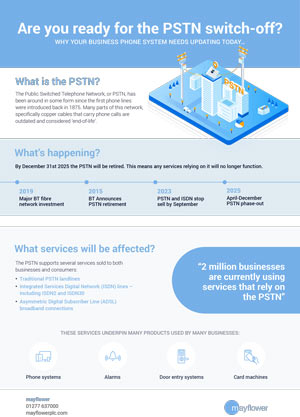In 2025 the way we make phone calls in the UK is going to change – whether we like it or not. Most people aren’t aware of the shift that’s coming, or how to prepare. Today we’re going to explain what the ISDN and PSTN switch off means for business, and how you can seamlessly transition to the new framework.
The top 5 things you need to know to prepare for the “BT ISDN switch-off” in 2025
1. How do we make calls now?
When telephones first gained traction, they sent messages over a network of copper wires – also known as a Public Switched Telephone Network (PSTN). This approach of sending voice messages has been the backbone of our communications system for more than 140 years.
Fast-forward 100 years or so from the days of Alexander Graham Bell and BT introduced something called an Integrated Services Digital Network (ISDN) in the UK, replacing analogue landlines with digital phone lines and generally upgrading the system. The ISDN and PSTN served the nation well for a few decades but as the internet began to revolutionise communications, the futurists at BT foresaw major change on the horizon.
2. BT announced the 2025 ‘switch off’ in 2015 giving 10 years to prepare
In 2015 BT announced that they would switch off their ISDN and PSTN services in 2025 as these technologies are no longer able to support the quantity of voice data being sent across a digitally connected world, nor does it enable the quality needed. Instead, it announced that from 2025, it will send all voice calls in the UK over the internet.
ISDN can no longer compete with broadband internet and it offers little flexibility. In addition, with more families and businesses using cloud-based storage and communications, it makes no sense to continue to invest in a technology that can’t support the future.
BT is now investing its energies and finances into improving the Voice over Internet Protocol (VoIP) technology which will replace the old network.
3. There are two choices available for business: VoIP and SIP
VoIP (also known as IP telephony) is a set of technologies that enables voice communication and multimedia sessions such as video conferencing, to take place over internet networks. It converts analogue voice calls into packets of data and these can travel over any public or private Internet Protocol (IP) network much in the same way as email or documents travel.
Session Initiation Protocol (SIP) is a set of rules – a protocol – used in multimedia communications to begin and terminate the transfer of data between the users. It is the way that a VoIP phone call is actually achieved. It is something like the traffic light that authorises and enables movement of data on the internet motorway, creating, modifying and terminating sessions (or calls) in the network, whether between two users or a whole group.
4. What’s the best option?
If you‘d prefer to buy a new phone system when the switchover happens and you already have ISDN lines at your business HQ, you’d likely be better off with VoIP. Most new office phone systems will support VoIP but you’ll need to make sure your internet connection has enough bandwidth to deliver voice calls.
If, however, you want to keep your current system after the switch, then SIP might be best for you.
Either way, you will need a stable internet connection that is capable of supporting IP telephony. If you are not sure if your internet will need upgrading, we can help you find out.
Here are some of the benefits you could look forward to:
- Reduced costs – call charges, line rental and infrastructure costs could reduce significantly
- New features – expect greater capabilities that will dramatically upgrade your internal and customer-facing communications, including seamless voicemail, CRM integration, calls from any device and much more
- Better service – your calls can be faster and customer communication more efficient
- Unified system – combine all your phone calls, messages, schedules, emails, apps and more into one system.
- Crisis recovery – you’ll have much faster recovery in the event of a disaster or system failure, with less downtime and data loss. Regular back-ups of all your data mean you can be back in action sooner – even within the hour.
5. Switching can take a couple of weeks depending on the size of your business
It’s actually quite simple to switch, once you’ve determined which route is best for your business. Get in touch with the friendly and helpful team at Mayflower for a free consultation; we’ll discuss your business requirements, such as how many phone extensions you might need and assess your current infrastructure. From there we can recommend the way forward, and handle all the set up for you.
A popular alternative to ISDN is something called SIP Trunks which utilise virtual phone lines rather than physical phone lines. SIP Trunks can support several different types of systems, including DCX and Direct Routing for Microsoft Teams. They are flexible, fast and provide high quality calls at lower costs.
Before you switch, you’ll need to plan how to port your existing contact details and numbers over to your new chosen system. Number porting is something Mayflower can help with. This process can take up to a few weeks depending on how many numbers you need to port, and what your current agreement is with your existing provider.
Plan your switch strategy now
We aim to ensure all our partners experience minimal disruption when moving from an old system to a future-proof new system, and we’d be delighted to support your business through this process. We can help you determine what system will best meet the needs of your business, including whether you might to upgrade to fibre optic internet or an Ethernet-based leased phone.
If you’ve already begun planning your transition strategy but need advice, do get in touch today. If this is all new to you, now is a great time to start getting informed and prepared.
If you have any question about the ISDN and PSTN switch off in 2025, we’d be delighted to help. Just phone, send us an email or book a free virtual consultation.



